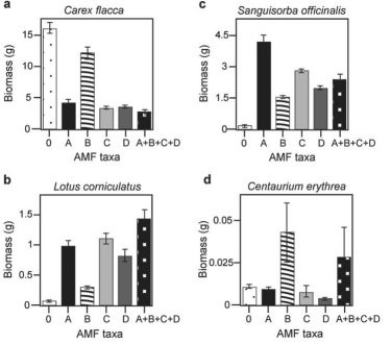Use the following information to answer the question.
Suzanne Simard and colleagues knew that the same mycorrhizal fungal species could colonize multiple types of trees. They wondered if the same fungal individual would colonize different trees, forming an underground network that potentially could transport carbon and nutrients from one tree to another (S. Simard et al. 1997. Net transfer of carbon between mycorrhizal tree species in the field. Nature 388:579-82) .
Pots containing seedlings of three different tree species were set up and grown under natural conditions for three years (Fig.A) . Two of the three species (Douglas fir, birch) could form ectomycorrhizal connections with the same fungal species, but the third species (cedar) could not form an ectomycorrhizal connection with the fungal species. In some of the pots, the researchers placed airtight bags over the Douglas fir and birch seedlings and injected carbon dioxide made from carbon-13 into the bags with the Douglas fir and carbon dioxide made from carbon-14 into the bags with the birch. (¹³C and ¹⁴C are different isotopes of carbon that can be detected and measured by researchers.) As the seedlings photosynthesized, the carbon dioxide was converted into sugars that could be tracked and measured by the researchers. The researchers measured whether the sugars in each plant contained only the carbon isotope that was in the air of their plastic bag or also the carbon isotope from the air around the other plant.
Simard et al. (1997) further hypothesized that if reciprocal transfer did occur, it would be a source-sink relationship driven by photosynthetic rates. That is, if one seedling is in full sun and the other in deep shade, there will be a net movement of carbon from the seedling in full sun to the one in deep shade. If a shade were placed over the birch seedlings and the cedar, and the Douglas fir was left in full sun, what result could Simard and colleagues expect?
Definitions:
Formal Communication Network
The structured and officially sanctioned channels of communication within an organization.
Informal Communication Network
The unofficial channels and pathways of communication in an organization, often referred to as the grapevine.
Illegal And Unethical
Actions or practices that are not only against the law but also violate moral standards of conduct.
Interferences
Distractions or obstructions that impede the clarity of communication or the effectiveness of a process.
Q15: The following table depicts characteristics of five
Q16: At one time, birds held the same
Q22: The chloroplasts of land plants are thought
Q28: According to the concept of punctuated equilibrium,
Q35: A fungal spore germinates, giving rise to
Q41: Healthy corals are brightly colored because they
Q42: Which of these are amniotes?<br>A) amphibians<br>B) fishes<br>C)
Q47: What adaptations should one expect of the
Q52: The inorganic nutrient most often lacking in
Q53: Soft-shell crab is a prized dish in